#athabaskan
Text
WEST INDIGENOUS NORTH AMERICAN RESOURCES
The Anthropological Masterlist is HERE.
The Western United States is a North American region that constitutes the western part of the United States. Alaska and Hawaii are also considered part of the Western United States.
AHTNA ─ “The Ahtna, or Ahtena, people are an Indigenous North American people. They are native to the Copper River in southern Alaska.”
─ Ahtna Information
ALEUT ─ “The Aleuts, or Unangas, are an Inuit people. They are native to the Aleutian Islands between Russia and Alaska.”
─ Aleut Information
─ Aleut Museum
─ Aleut Language
ATHABASKAN ─ “Athabaskan, or Dene, is an Indigenous American linguistic group that share the Athabaskan language family. They are native to Alaska, north Canada, and southwest United States of America.”
─ Athabaskan Languages
─ Athabaskan Language Conference
CAHUILLA ─ “The Cahuilla, or Ivilyuqaletem, people are an Indigenous North American people. They are native to the center of southern California.”
─ Cahuilla Information
─ Cahuilla Language
─ Cahuilla Language
CROW ─ “The Crow, or Absaroka, people are an Indigenous North American people. They are native to central and south Montana.”
─ Crow Information
─ Crow Language
HOPI ─ “The Hopi are an Indigenous North American people. They are native to northeastern Arizona.”
─ Hopi Information
─ Hopi Culture and History
─ Hopi Dictionary
INUIT ─ “The Inuit are an Indigenous North American people. They are native to Greenland, Canada, and Alaska.”
─ Inuit Collections
─ Inuit Religion
─ Inuit Dictionary
KUMEYAAY ─ “The Kumeyaay, or Tipai-Ipai, people are an Indigenous North American people. They are native to southern California.”
─ Kumeyaay Culture
─ Kumeyaay Language
─ Diegueño Dialect
KWAKWAKA’WAKW ─ “The Kwakwaka’wakw, or the Kwakiutl, people are an Indigenous North American people. They are native to Vancouver Island.”
─ Kwakwaka’wakw Mythology
─ Revival of the Kwakwaka’wakw Langauge
─ The Bible in Kwakwaka’wakw
LUISEÑO ─ “The Luiseño, or Payómkawichum, people are an Indigenous North American people. They are native to the coastal area of southern California.”
─ Luiseño Culture
─ Luiseño History
─ Luiseño Language
MIWOK ─ “The Miwok, or Miwuk, people are an Indigenous North American people. They are native to northern California.”
─ Miwok Mythology
─ Miwok History
─ Miwok Dictionary
NAVAJO ─ “The Navajo, or Diné, people are an Indigenous North American people. They are native to the southwestern United States of America.”
─ Navajo Culture
─ Navajo Mythology
─ Navajo Language
O’ODHAM ─ “The O’odham people are an Indigenous North American people. They are native to the Sonoran Desert in Arizona.”
─ O’odham Dictionary
PAIUTE ─ “The Northern Paiute people are an Indigenous North American people. They are native to the Great Basin in the United States of America.”
─ Paiute Culture
─ Paiute Culture
─ Paiute History
PUEBLO ─ “The Pueblo, or Puebloan, people are an Indigenous North American people. They are native to New Mexico and Arizona.”
─ Isleta Pueblo Information
SHOSHONE ─ “The Shoshone, or Shoshoni, people are an Indigenous North American people. They are native to Wyoming, Idaho, and Nevada.”
─ Shoshone Information
─ Shoshoni Language Project
SNOHOMISH ─ “The Snohomish people are an Indigenous North American people. They are native to the Puget Sound area of Washington.”
─ Snohomish Culture and History
TEWA ─ “The Tewa are an Indigenous North American people. They are native to the Rio Grande, New Mexico.”
─ The Ethnogeography of the Tewa Indian
WINTUN ─ “The Wintun people are an Indigenous North American people. They are native to North California.”
─ Wintu Language
ZUNI ─ “The Zuni, or Zuñi, people are an Indigenous North American people. They are native to western New Mexico.”
─ Zuni Culture
─ Zuni Culture
─ Zuni Language
#resources#western united states#ahtna#aleut#athabaskan#cahuilla#crow#hopi#inuit#kumeyaay#kwakwaka'wakw#luiseño#miwok#navajo#o'odham#paiute#pueblo#shoshone#snohomish#tewa#wintun#zuni
56 notes
·
View notes
Text
youtube
Non-English Songs Celebrates Christmas #19 | Jana Mashonee - O Holy Night (Navajo)
#traditional christmas carol. made me cry#jana mashonee#o holy night#navajo#diné bizaad#nav#athabaskan#nadené#nadene#north america#2008#2000s#religious#religious christmas#christmas#Youtube
0 notes
Text

Looking at some northern Athabaskan languages. How often do you see dental affricates?! Cool stuff.
(Source: Kaska language on Wikipedia)
6 notes
·
View notes
Text

HMCS Athabaskan, Halifax, 1990
#HMCS Athabaskan#Halifax#1990#RCN#Royal Canadian Navy#Destroyer#Iroquois Class#naval#nautical#photography#hide and queue
11 notes
·
View notes
Photo

[TASK 300: ALASKAN ATHABASKAN PEOPLES]
In celebration of Native Heritage Month being November (info in source link below), there’s a masterlist below compiled of over 20+ Alaskan Athabaskan faceclaims categorised by gender with their occupation and ethnicity denoted if there was a reliable source. A list of the specific peoples/ethnic groups that are Alaskan Athabaskan is also included with the list below. If you want an extra challenge use a randomizer to pick a random number! Of course everything listed below are just suggestions and you can pick whichever faceclaim or whichever project you desire.
Any questions can be sent here and all tutorials have been linked below the cut for ease of access! REMEMBER to tag your resources with #TASKSWEEKLY and we will reblog them onto the main! This task can be tagged with whatever you want but if you want us to see it please be sure that our tag is the first five tags, mention us or send us a messaging linking us to your post!
THE TASK - scroll down for FC’s!
STEP 1: Decide on a FC you wish to create resources for! You can always do more than one but who are you starting with? There are links to masterlists you can use in order to find them and if you want help, just send us a message and we can pick one for you at random!
STEP 2: Pick what you want to create! You can obviously do more than one thing, but what do you want to start off with? Screencaps, RP icons, GIF packs, masterlists, PNG’s, fancasts, alternative FC’s - LITERALLY anything you desire!
STEP 3: Look back on tasks that we have created previously for tutorials on the thing you are creating unless you have whatever it is you are doing mastered - then of course feel free to just get on and do it. :)
STEP 4: Upload and tag with #TASKSWEEKLY! If you didn’t use your own screencaps/images make sure to credit where you got them from as we will not reblog packs which do not credit caps or original gifs from the original maker.
THINGS YOU CAN MAKE FOR THIS TASK
Stumped for ideas? Maybe make a masterlist or graphic of your favourite faceclaims. A masterlist of names. Plot ideas or screencaps from a music video preformed by an artist. Masterlist of quotes and lyrics that can be used for starters, thread titles or tags. Guides on culture and customs.
Screencaps
RP icons [of all sizes]
Gif Pack [maybe gif icons if you wish]
PNG packs
Manips
Dash Icons
Character Aesthetics
PSD’s
XCF’s
Graphic Templates - can be chara header, promo, border or background PSD’s!
FC Masterlists - underused, with resources, without resources!
FC Help - could be related, family templates, alternatives.
Written Guides.
and whatever else you can think of / make!
CLICK HERE FOR MASTERLIST!
#alaskan athabaskan fc#alaskan athabascan fc#athabaskan fc#athabascan fc#native fc#indigenous fc#poc fc#fc of color#fc list#rph#underused fc#task: 300#task: alaskan athabaskan peoples
9 notes
·
View notes
Text
LITERALLY I can tell the way y'all see native cultures as a monolith when y'all draw Water Tribe folk. Please look up actual Inupiaq or Yu'pik or even Athabaskan outfits Jesus Christ it's not desert wear with extra fur and triangles
#not saying geometry isn't a part of the style but the way y'all draw them smfh#like seriously put two seconds of effort in I'm begging you#don't just look up 'native outfits' and color it blue I've SEEN IT MORE THAN ONCE#I mean Athabaskan area is a different area than the others slightly#it's been a long time since I've seen a map ok I'm just tired
3 notes
·
View notes
Note
Hey, would you be willing to elaborate on that "disappearance of the Anasazi is bs" thing? I've heard something like that before but don't know much about it and would be interested to learn more. Or just like point me to a paper or yt video or something if you don't want to explain right now? Thanks!
I’m traveling to an archaeology conference right now, so this sounds like a great way to spend my airport time! @aurpiment you were wondering too—
“Anasazi” is an archaeological name given to the ancestral Puebloan cultural group in the US Southwest. It’s a Diné (Navajo) term and Modern Pueblos don’t like it and find it othering, so current archaeological best practices is to call this cultural group Ancestral Puebloans. (This is politically complicated because the Diné and Apache nations and groups still prefer “Anasazi” because through cultural interaction, mixing, and migration they also have ancestry among those people and they object to their ancestry being linguistically excluded… demonyms! Politically fraught always!)
However. The difficulties of explaining how descendant communities want to call this group kind of immediately shows: there are descendant communities. The “Anasazi” are Ancestral Purbloans. They are the ancestors of the modern Pueblos.
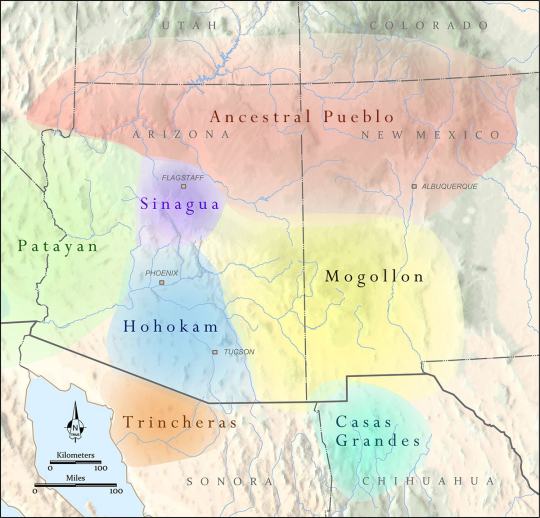
The Ancestral Puebloans as a distinct cultural group defined by similar material culture aspects arose 1200-500 BCE, depending on what you consider core cultural traits, and we generally stop talking about “Ancestral Puebloan” around 1450 CE. These were a group of people who lived in northern Arizona and New Mexico, and southern Colorado and Utah—the “Four Corners” region. There were of course different Ancestral Pueblo groups, political organizations, and cultures over the centuries—Chaco Canyon, Mesa Verde, Kayenta, Tusayan, Ancestral Hopi—but they generally share some traits like religious sodality worship in subterranean circular kivas, residence in square adobe roomblocks around central plazas, maize farming practices, and styles of coil-and-scrape constructed black-on-white and black-on-red pottery.
The most famous Ancestral Pueblo/“Anasazi” sites are the Cliff Palace and associated cliff dwellings of Mesa Verde in southwestern Colorado:

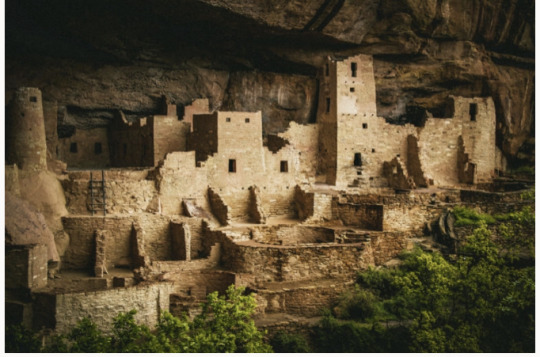
When Europeans/Euro-Americans first found these majestic places, people had not been living in them for centuries. It was a big mystery to them—where did the people who built these cliff cities go? SURELY they were too complex and dramatic to have been built by the Native people who currently lived along the Rio Grande and cited these places as the homes of their ancestors!
So. Like so much else in American history: this mystery is like, 75% racism.
But WHY did the people of Mesa Verde all suddenly leave en masse in the late 1200s, depopulating the whole Mesa Verde region and moving south? That was a mystery. But now—between tree-ring climatological studies, extensive archaeology in this region, and actually listening to Pueblo people’s historical narratives—a lot of it is pretty well-understood. Anything archaeological is inherently, somewhat mysterious, because we have to make our best interpretations of often-scant remaining data, but it’s not some Big Mystery. There was a drought, and people moved south to settle along rivers.
There’s more to it than that—the 21-year drought from 1275-1296 went on unusually long, but it also came at a time when the attempted re-establishment of Chaco cultural organization at the confusingly-and-also-racist-assuption-ly-named Aztec Ruin in northern New Mexico was on the decline anyway, and the political situation of Mesa Verde caused instability and conflict with the extra drought pressures, and archaeologists still strenuously debate whether Athabaskans (ancestors of the Navajo and Apache) moved into the Four Corners region in this time or later, and whether that caused any push-out pressures…
But when I tell people I study Southwest archaeology, I still often hear, “Oh, isn’t it still a big mystery, what happened to the Anasazi? Didn’t they disappear?”
And the answer is. They didn’t disappear. Their descendants simply now live at Hopi, Zuni, Taos, Picuris, Acoma, Cochiti, Isleta, Jemez, Laguna, Nambé, Ohkay Owingeh, Pojoaque, Sandia, San Felipe, Santa Clara, San Ildefonso, Tamaya/Santa Ana, Kewa/Santo Domingo, Tesuque, Zia, and Ysleta del Sur. And/or married into Navajo and Apache groups. The Anasazi/Ancestral Puebloans didn’t disappear any more than you can say the Ancient Romans disappeared because the Coliseum is a ruin that’s not used anymore. And honestly, for the majority of archaeological mysteries about “disappearance,” this is the answer—the socio-political organization changed to something less obvious in the archaeological record, but the people didn’t disappear, they’re still there.
332 notes
·
View notes
Text
THE MAN ON THE TAIL: AN ALASKA AIRLINES WHOISIT
Last time on Runway Runway...
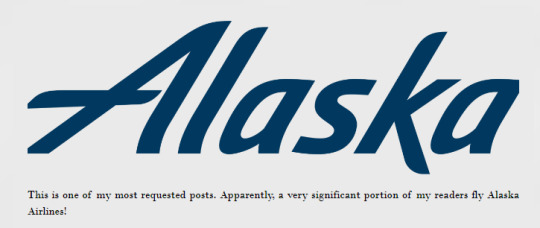

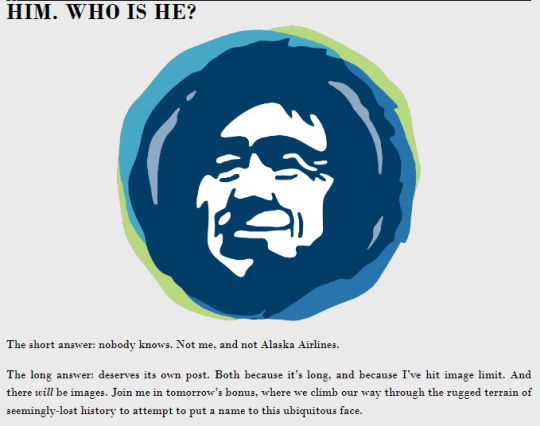
The short answer, reiterated: nobody knows.
The long answer: Nobody knows. A lot of people have no idea or have never even thought about it. Many people have a person in mind they think he resembles, but they know that it's probably wrong. A non-negligible number think they know, but they do not necessarily agree with each other. After the research I have done on the topic, I believe that I do know who this face is, but this is not going to be an argument for my position - merely a presentation of this logo's origins and the theories as to who this face represents, a few thoughts about community and feeling like something is part of yours, and the story of an incredible man.
But first, a content warning, and a disclaimer:
This post will discuss use of an outdated term used to refer to Inuit and Yupik peoples which is broadly considered offensive. It is, unfortunately, inseparable from the story of the face on Alaska Airlines' tailfins. While I have discussed somewhat heavy subjects, including racism, on this blog before, it has generally been in reference to statistics or vague allusions to commonly held offensive sentiments, and I think that discussing a specific word which has caused pain to a group of people requires a little bit more of a specific warning.
Below the cut, there will be discussions surrounding Alaska Airlines' use of said word, with a bit on its broader context. This post is not meant to be a downer, and I don't think it ultimately is. But there is a lot to the story of the "happy face", and there is no use telling the warm and fuzzy parts inside the hood of the parka while ignoring the temperature outside of it. There is so much more to this story than outdated language, but it is still a part of it that can't be left out without overlooking the very people who the tail represents.
I imagine the context of that warning, unfortunately, becomes clear immediately.
Indigenous Alaskans make up 15% of the state's population, made up of various groups of what are called 'circumpolar peoples', who historically lived in the very northernmost habitable parts of the planet - Alaska, Siberia, Greenland, and parts of Canada and Scandinavia. While these groups are broadly somewhat related they are distinct in culture and history.
Alaska, specifically, has over 200 federally recognized tribes, around the same number as is present in the entire rest of the country. (That has its own context, but my point here is to illustrate the diversity of indigenous Alaskan background.) These cultures include the Athabaskan, Aleut, Eyak, and the two that those without personal familiarity tend to think of - the Yup'ik and Iñupiaq. All of these terms themselves further comprise multiple communities, and indeed Yup'ik and Iñupiaq refer to specific groups of peoples from the larger groups of Yupik and Inuit peoples - the groups in question being the ones who live in Alaska rather than Siberia or Canada.
The reason this is important is that it is generally agreed that the face on Alaska Airlines' airplanes is an Alaskan Native, and specifically a member of one of these two groups. A few people apparently assume him to be Abraham Lincoln or Bob Marley or some other famous person (in fact, I am editing this to say that one of the replies to my first post was someone saying they'd always thought it was Abraham Lincoln) but I doubt these theories are ever serious. It would be weird to put a representative from Kentucky on a livery for Alaska Airlines (...which admittedly is based in Washington). The reasons for this assumption are fairly straightforward - it's a reasonable leap from a face surrounded by what looks like a fur hood being identified as Alaskan. But I wouldn't be making this post if the answer was just 'eh, some Alaskan Native'. (And I would find using the generic ornament of an indigenous group as branding more than a little tasteless, in all honesty.) It is broadly thought that this logo is based on the likeness of a specific individual. The question is who.
MEET OUR MYSTERY MAN
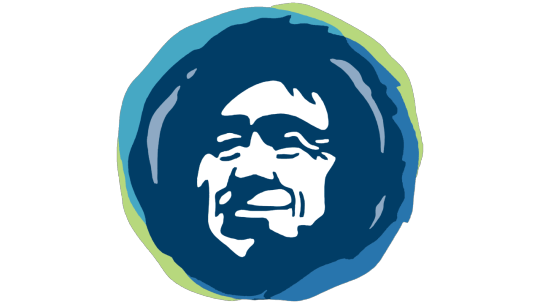
So, let's start at the obvious place. He's their logo, so...what does Alaska Airlines say about the identity of this mystery man? Let's take a look at the press release for their 2016 rebrand.

I'll be honest, I wasn't keeping up with airline livery news in 2016. Indeed, I wasn't keeping up with much of anything and I can't recall much from that period. So I...did not know about this, and it took the wind out of me a bit when I learned it happened.
So, let's begin with that term. 'Eskimo'. I feel gross even typing it. This is an exonym used to refer broadly to Yupik and Inuit peoples, though many who use it aren't necessarily aware that the term refers to multiple distinct cultures. I've heard it used for the Alaska Airlines man, and I had always assumed this was out of the ignorance of individual people. I live in the United States, where it's still often used casually (as are a few other unfortunate terms other places avoid - the country seems to have perpetually not gotten the memo, so to speak). In Canada, it is more or less universally considered to be offensive, due to the groups in question expressing their opposition to its use, and this seems to be the general trend over time in the US as well. So while, unfortunately, I do hear people casually say it from time to time, that's mostly annoying classmates. I didn't expect to hear it from Alaska Airlines.
The phrasing, however, is just as much of a problem. 'Our' Eskimo, as a probably unintentional consequence of phrasing choices, implies ownership of not just the logo but the man himself. I don't think I particularly need to explain why some might take issue with this.
And take issue they did. There was a petition! The hashtag #notyoureskimo was started on the website formerly known as Twitter. Anchorage Daily News quotes user angelascox making a statement I think really cuts to the quick of it: "No, @AlaskaAir … you don't own an Eskimo."
Alaska Airlines did listen.

Well, that's..........better, I guess. Unfortunately, it does still use the word 'Eskimo'. And I should note that it isn't universally considered offensive and I've found Alaskan Natives who state that they don't mind use of the term, but these seem to be the minority, and as time goes on it's being phased out further and further. In the context of Alaska Airlines' use, the Anchorage Daily News provides a few perspectives:
Maria Shaa Tlaa Williams, director of the Alaska Native Studies program at the University of Alaska Anchorage and Tlingit, said in an email the broader issue is about the use of "a somewhat antiquated word."
"(Eskimo) is a colonial term and it should be: Inupiaq, Yup'ik/Cup'ik, Siberian Yupik or even Inuit, or even generic term such as Alaska Native," she said.
Bobbie Egan, media relations director for Alaska Airlines, said the company made the decision to keep using the word "Eskimo" after conducting focus groups with Native leaders throughout Alaska, but she did not have details about those focus group results.
"Many of our employees and customers commonly refer to themselves as Eskimo and we've always sought the input and counsel of employees and customers," she said.
I do wish those focus group results were made public, but all the same this isn't particularly surprising. Whenever a term begins to be considered offensive this opinion is generally adopted in a bit of a mosaic fashion, with typically younger people first expressing discomfort and those from different walks of life having their own opinions - some more swayed by the distasteful aspects, while others refuse to let that stop them from using a word they've called themselves their whole life. This is broadly true across all sorts of contexts. I do think it's never an outsider's place to critique someone's choice to use whatever language they feel best represents them, but if there is a large portion of the group in question who find it derogatory we should avoid using it ourselves. There are certainly 'outdated' terms I use for myself but would feel a bit unhappy seeing used carelessly by someone who didn't understand what it meant and was using it, bluntly, because they didn't know better or didn't care to know better. If you are from a group which has historically been derided by others you can probably fill in your own example here.
There are a few reasons for the distaste many have for the word 'Eskimo'. To begin with, it's an exonym. This term was not used as an identifier by any of these groups, but by outsiders to refer to them, and particularly by Europeans and settlers who heard these words from other groups they encountered earlier and then never bothered to ask the people in question what they actually called themselves. Beyond the inherent issue of self-determination, the fact that these were the historical users means that it was often pejorative and othering and ought to be left behind with terms like 'oriental'.
The term is generally thought to have originated from a corruption of an exonym used by one or more Algonquian-speaking groups. The most popular conception is that it stems from a Cree term meaning 'raw meat eater', which people understandably find pretty offensive. There are a number of other theories, and recently linguists seem to most support an interpretation that it is derived from an Innu-aimun word meaning 'one who laces a snowshoe'; it could have evolved from both of these terms or neither, and I don't think it matters when it is already widely perceived as meaning something offensive. 'Well, actually'-ing somebody who says a term is offensive to their ethnic group by pointing out a benign linguistic origin is a pretty pointless thing to do - we've had this conversation before about the name Lufthansa. But beyond that, basically every slur I can think of was once a completely innocuous word that just needed someone to invent a hateful enough way to use it. And people have been using this word rather hatefully for centuries. Regardless of origin, it is a dated exonym, and if the groups it refers to don't feel it represents them that's enough reason for me to stop using it.
The other reason that this term is broadly bad to use is that it's just not a good way of conveying which people you're talking about. 'Eskimo' is generally agreed to encompass Yupik and Inuit peoples, which are two large and diverse populations spread across Siberia and North America. These may be closely related and similar cultures but they are not interchangeable. 'Inuit' has recently seen more frequent use as a replacement, which is at least a step away from the language, but is often outright factually incorrect, as it will be used to refer to Yupik people - who are not Inuit, but are the largest indigenous population in Alaska. 'Alaskan Native' and 'circumpolar peoples' exist as umbrella terms which are understood to be umbrella terms by just about everyone, but there is a legitimate misconception that these groups are all the same because of the use of a single term for them.
Maybe Alaska Airlines uses the term because they think 'Alaskan Native' is awkward for a slogan and they don't want to tie themselves into knots by committing to specifying whether the man is Yup'ik or Iñupiaq. That would be a problem, as they don't actually know who he is.
Beyond the term, there is the issue of objectification on a larger scale than phrasing. Annie Wenstrup, the writer of the petition linked earlier, makes an important point - if the Alaska Airlines man is the likeness of a real person, that person has not been paid for its use. Beyond that, Alaska Airlines is using the very concept of an indigenous Alaskan to market itself. There is definitely a dehumanizing element to it. Alaska Airlines is far from the only company to have ever used ethnic groups as branding, and I think that ultimately it's not my place to linger on this topic. It would be wrong to not mention that this is an element of his story, that people do raise this issue, and that this is a discussion that should be had. I, however, don't have a fully developed opinion. This is a conversation for Alaskan Natives to have, I think - I just don't understand the context of their relationship with the airline specifically, and I have no more ownership of the man pictured than Alaska Airlines. Because he was not an object. There is every likelihood that he was a real person.
WHO IS THE MAN ON THE TAIL?
The website mentions a short film. Unfortunately, the Way Back Machine didn't manage to get it, but it did catch the associated article. The thing this article communicates most clearly is that nobody knows who this man is.
Whether the artists were inspired by [a real person] remains a mystery to this day – both within the company and without – as no official documentation has ever been uncovered indicating that [...] the Eskimo [...] was based on a specific person.
Even Alaska’s archivists, a team of retirees and long-time employees passionate about preserving the company’s history, can’t agree.
As someone who is myself studying to be an archivist, I am currently tearing my hair out and flinging tables at people mere decades ago for never keeping any records!!! What is wrong with you people?! Why do you never think of me in the future wanting to know the context of things you probably think are obvious?!
Well, anyway, this might indicate that he's just a generic representation of an Alaskan Native. That would not just be a disappointing answer to this mystery, it would also be pretty offensive. I know that the NFL (an organization known for its racial sensitivity, as I think we're all aware) is a bit slow to catch onto this but I think at this point in history we're all on the same page about using indigenous groups as mascots, right? It's weird and dehumanizing. But that's generally in reference to a stock character based on a stereotype of this group, and often one which is an offensive caricature. Given the percentage of Alaskan Natives in the population, some of whom were certainly involved in making Alaska Airlines what it is, isn't there a chance that this is a loving homage to the group native to the land this airline represents? A way of saying 'this is who this airline connects to faraway places'? I think this was certainly at least the intention, and whether this is still tokenizing, whether the phrasing on the website - a warm, welcoming presence and a reminder of commitment - stirs up an uncomfortable feeling is ultimately a question for Alaskan Natives, and one with a far less unanimous answer than that of outdated terminology.
However, I'll say this up front: he is not a generic representation. He is a specific individual. If he weren't I wouldn't have written a whole post about him.
So let's go all the way back to the beginning. If we do this we find our mystery man was actually not created to be a generic literal face of Alaska Airlines. The intention was not an indigenous mascot, but to represent Alaska's heritage...in more than one way. Mr. Alaska Airlines was once a jellybean.
YOU MIGHT AS WELL PUT HIM ON THE TAILS

image: Vic Warren
In 1972 a set of four new "Alaskana" liveries were introduced for Alaska Airlines' relatively small 727 fleet, replacing the older 'Gold Nugget Jet'. (I will definitely be reviewing those one day.) They were designed by Vic Warren and meant to represent the heritage of Alaska's population, and came in four variants:
"The Prospector" - in red, a miner with his pick, representing the people who flocked to Alaska from the lower 48 during the Gold Rush
"The Totem Pole" - in green, a totem pole design representing Southeast Alaskan indigenous groups such as the Eyak, Tlingit, and Haida - I wish I could be more specific but I can't seem to find the specific totem pole this is based off of
"The Onion Dome" - in fuchsia, today I learned that's actually what those are frequently called! They are meant to represent the history of Russians in Alaska.
And, "The....you know. Him." He's in blue. You may notice he looks a little bit less genial here. , and there's a bit of lighter color detail. No elaboration needed.
It does feel distinctly less tokenizing when there's a white prospector right next to him. In fact, the rephrasing in the quote taken from the archivists is actually because they were referring to both our mystery man and the prospector, whose identity is even more lost to history. This feels quite a bit less sinister than naming your football team a racial slur. It's like if an airline representing Massachusetts (keep reading, Cape Air, this is a free idea for you) had a set of jellybeans featuring a Wampanoag person, a furious man in the process of being given a traffic citation, a whale, a large textile workers' strike, a university-aged Dunkin Donuts employee who can just barely cover the rent at the two-bedroom apartment they share with seven roommates, Giles Corey being pressed to death, Paul Revere, the Harvard University logo, and Tom Brady. It goes from feeling exclusively dehumanizing to
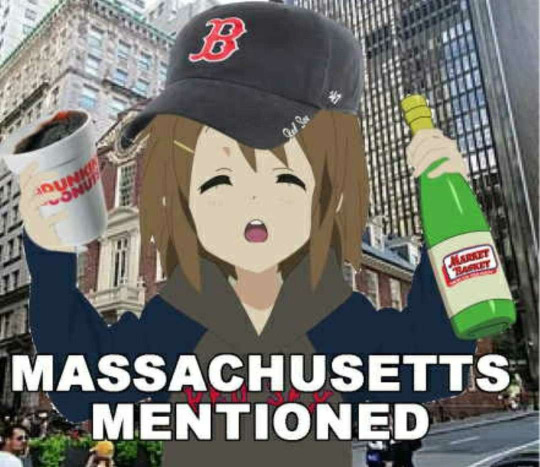
Over the years, though, use of the other three designs dropped off. I'm not sure why it did (well, I can hazard a guess about the Onion Dome) but that's just the reality. Maybe the totem I understand being difficult to immediately identify as a totem when it's in monocolor with little detail on a large plane. I do think it's a bit of a shame - I love jellybeans and I love representing more than one culture in a place as large as Alaska - but I get it, their fleet was small.
As for why our mystery man won the deadlock with the Prospector, that's beyond me, but it almost feels like it was destined given he was the initial basis for the concept at all. Again from Vic Warren:
The first time the Eskimo art was used was in a large newspaper ad promoting Arctic Tours. [...] Since it was a newspaper ad, the initial appearance of the Eskimo was as a large, strong black image. The marketing director at Alaska hated it, even though the ad performed well. [...]
A few months later, [I was] given the assignment to create a new corporate image for the airline [...] At this time the airline [...] only flew from Seattle to Alaska and within Alaska. They had recently moved their headquarters from Anchorage to Seattle and were taking a lot of political flak for abandoning Alaska. Our direction from the airline was to “create something very distinctive and modern, yet totally Alaskan.”
In retrospect, it sounds easy, but I worked for three months on every kind of jet design I could think of. [...] the airline’s account executive was sitting with me in my office. [...] He stood up and stomped out of the room, shouting, “Oh, to hell with it! You might as well put that damned Eskimo on the tails!” Ta-daaaaaa!
[...] I looked at the history and culture of Alaska and came up with four designs [...] But it shortly became evident that the Eskimo was the most popular image. And it was expensive to use all those different designs, so the other three left.
And thus Mr. Alaska Airlines was brought on board properly. And people were very attached to him. The thing mentioned earlier, that the airline was getting flak for losing their Alaskan identity - that comes back later in 1988, when the airline considered replacing him with a logo of a stylized mountain in the shape of the letter A. People hated this new logo so much I cannot even find a picture of it. This attempted replacement was for reasons unrelated to the criticisms I've mentioned earlier - he looked bad when printed small, was difficult to recognize, and might suggest to the people of California that Alaska Airlines only flew to Alaska. People were so incensed about this idea, however, that the state legislature decided this was a problem for them to tackle. From the LA Times:
The Alaska Legislature, which went into session on Monday, will consider a resolution asking the Seattle-based airline not to junk the colorful logo for one featuring a stylized mountain, said state Sen. Tim Kelly of Anchorage.
[...]
Alaska’s 20 state senators have voiced support for the resolution, he said.
Do they not have anything better to do with their time? No...zoning laws or tax brackets or ordinances? I mean, they've got some experience in aviation, I guess - they did make it illegal to push a moose out of a plane, or to look at moose from a plane. You also can't get a moose drunk. Actually, they have a lot of oddly specific moose-related laws, which I think is a form of environmental storytelling. You also can't wake up a sleeping bear to take a photograph of it. Safety is a priority, though - it's illegal to sell a child a stun gun and you need a concealed-carry permit for slingshots, so their priorities are clearly in important places.
Regardless, one thing Kelly said stood out to me. Emphasis mine:
“It may not be the best representation of an Eskimo, but it’s our Eskimo,” he said. “(Alaskans) feel an affinity with the airline. Alaskans feel it’s their airline.”
Okay, so this could be one of two things: a coincidence (more plausible, I guess, since it's not that weird of a combination of words) or an intentional reference to this statement by the company, which I think I would respect a bit more - a nod to history, all that - but if this is the case it seems quite strange they wouldn't have mentioned it as context for the use of their phrase when apologizing for it. Not important, just wanted to bring it up.
Despite the fact that the airline got a letter of support - “a graphic designer who is related to a pilot thought it was good"- they obviously did not replace him. Vic Warren actually weighed in himself on the topic:
My position was that if the airline’s image was confusing, it was because of the name Alaska Airlines, not the Eskimo logo. If they wanted to be a more amorphous regional carrier they should change their name to a version in the Air West mold or, at any rate, something less specific than Alaska.
And I do think I agree with him. You can choose between being relatable to everyone or having a heritage, making your brand just as much about where you started as where you are. I prefer the latter, but I have the opposite mindset of an airline. I am all about history and expression, and don't remotely care about attracting customers or making money. There is a reason Alaska Airlines doesn't have a tumblr blog.
“The Eskimo is a friendly, human symbol of the north, of the spirit of Alaska,” wrote Satch Carlson, an Anchorage Daily News columnist. “Take him off the Alaska planes in favor of some abstract, hip, meaningless design, you’re taking one step closer to that impersonal austerity that characterizes most other airlines today.”
...wow, so even in '88 they were tired of Eurowhite, it seems.
THAT LOGO THAT LOOKS LIKE MY TIO
So of course they kept the face. He got tweaked over the years - the 'fly with a happy face' campaign adjusted him to look a little bit less stoic, and of course the details were updated as graphics technology improved. But this is The Alaska Airlines Guy now. People are attached to him. An interesting effect of this attachment, though, is that a lot of people are pretty sure they know who he is, and that he's from their town.
People already recognize him as any number of a massive slew of celebrities. I find this extra fascinating because I actually have congenital prosopagnosia - I cannot recognize human faces, and while I can generally identify people in daily life by context like voice, posture, fashion sense, and hair, recognizing people from photographs is far more difficult. Unless I have two pictures next to each other and can compare the individual features it's basically useless - I never get that sort of 'click' of recognition - so it's been really interesting reading all the different associations people had, of which I have seen literally dozens if not hundreds. Reddit user DaBigBird27, in one of my favorite anecdotes, relates an experience where he was told by an LAX employee to look for the logo that looks like "his tio". And isn't it incredibly fascinating how that works? How you can tell someone you've only just met to find the picture that looks like your tio, and they'll know what you mean?
Look, there's something about grandfathers. I don't know what it is. (Uncles too, probably - I don't have any, though.) I hope I'm not insane for saying this, so any other grandfather enjoyers can weigh in, but I feel like grandfathers occupy a certain formative place in everyone's mind. He is one's earliest exposure to an old man and thus becomes their fundamental conception of one. Unless he is phenomenally cruel this ties him together, part and parcel, with the features of old men that can bring you comfort and happiness. I certainly experience this with my grandfather, despite having known him for a really tragically short length of time. If I were able to recognize faces, I think there's a very real chance that I would have thought the Alaska Airlines man was him for a moment.
And this seems extra true for those from Alaska. The Anchorage Daily News continues to provide a lot of anecdotes of locals discussing the universal feeling of proximity to the logo.
Perry Eaton, an Alutiiq artist who is originally from Kodiak Island but now lives in Anchorage, said that some people insist they know the Eskimo's true identity.
"It's always been sort of a tongue-in-cheek conversation," Eaton said. "Nobody's gotten emotional over it, it's just sort of interesting. He's very iconic. Some folks are adamant that they know who it is."
“If you’re from Barrow, you think maybe he’s from Barrow. If you’re from Kotzebue, you think maybe he’s from Kotzebue. If you’re from Nome, you think maybe he’s from Nome,” says former mayor Lukin. “I have not met an Eskimo elder who doesn’t sort of smile like that.”
Another piece of writing, although accompanying a story that (as far as I can tell) is fiction, or at least dramatization, contains some context that is definitely not:
By the way, that page also had a lively discussion which included a number of other theories about the origin of the image, a number of people claiming a family relationship with the person depicted [...]
Whatever the case, the image has obviously evolved and become less stern over the years. When the image was digitized there were further touch-ups and adjustments made. Most sources agree, though, that a remarkable number of native Alaskan people say that the person: “looks just like my grandfather!”
Even Alaska Airlines' own (archived) website describes this phenomenon.
“When I was a little kid, we all thought it was our own grandfathers,” says former Kotzebue mayor Maija Lukin. “We all thought it was our tata. Even if it didn’t remotely look like our grandfathers.”
Well, let me finally get to the point, because at least some of these people are correct. While he was intended to represent Alaskan Natives as a whole, the man was based on the likeness of a real person. There are two leading theories thought to be plausible. Both were real Alaskan Natives with ties to aviation who lived memorably in the proper timeframe to have inspired the logo.
CHESTER SEVECK
I'll begin with Chester (his full name seems to have been Chester Asagaq Seveck Downey but he is most frequently called Chester Seveck), who is the more common theory. (And indeed the man on the tail is frequently referred to as 'Chester' by people who think this.) The above-quoted Kotzebue mayor, for example, is convinced it's Chester, who was himself a Kotzebue resident. It's a remote place which relies on air travel to provide necessities, and Chester was said to have greeted passengers and crew as they left the airplanes together with his wife. He was often mentioned to be a reindeer herder, but I was afraid that this would be all I could find about this man who clearly was beloved by so many people that to this day he's remembered this widely.
Thankfully, unlike so many people who pass into history with only vague and distant reference to memorialize their full and remarkable lives, Chester Seveck has written a memoir, published by a bush pilot who considered him a close friend. It's called Longest Reindeer Herder and is available in its entirety for free, with the pilot and friend in question, Frank Whaley, including a selection of photographs he himself took of Chester. I really recommend everyone read it. It's not very long but it's extremely dense with information, giving a first-hand account of the development of airborne connections between remote regions from the side that doesn't normally get to tell their story. It also tells a lot about Chester, his family, and the incredible things which happened to him. One that really stuck with me was the time he was shot with a rifle but unharmed, because his parka absorbed the force of an entire bullet! It reads almost like a journal, very matter-of-fact and brief recounting of events which would have at the time been whirlwinds of emotions and little details now lost to the steady flow of history, but all of this was put to paper at once, and it's staggering just how much one life really is, how much we can learn from just some of one man's memories. About him, about the world he lived in, and about reindeer herding.
When it comes to aviation, Chester's experiences are a joy to read. He recounts his first time coming to the US, together with his wife.
Then Jack Whaley take us to Los Angeles. We flew in night time. We saw the lights down under us. I remember when we newly married in the year 1912 July 12th, I was dreaming my wife and I we saw the stars and sky under us. We were above the sky and stars I told my wife. Now my dream come true.
Eventually Chester, too old to continue his work with massive herds of reindeer, retired and began to work for Wien Airlines, traveling for promotional tours and guiding tours in Kotzebue. He refers to this as 'herding tourists'.
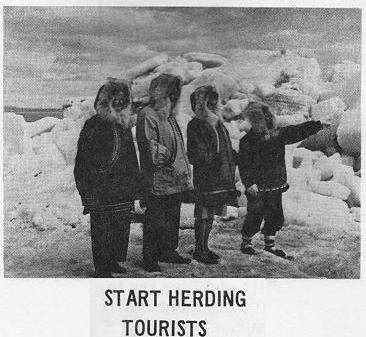

There are stories of the Lower 48, too, of the tours he went on with his wife. He mentions appearing with Steve Allen, Art Linkletter, and even Groucho Marx. He appeared in a minor role in "Ice Palace" (1960), a very poorly reviewed film which also happened to be the motion picture debut of one George Takei.


The final section of his memoir:
For long live and joy life, I believe these things--Keep busy and do good work. Have much good exercise. Eat good food, no waste anything and every day enjoy what it gives and do not spoil this day with much worry of tomorrow.
Be happy. I know this way how I be "Longest Reindeer Herder." Start 1908, finish 1954, altogether 46 years herd reindeer.
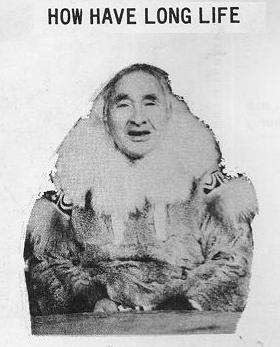
Chester was undeniably a gregarious person. He seemed to really genuinely enjoy the high profile his partnership with Wien brought him, not for any material gains but because seeing the world and showing it to other people made him happy. He had a high opinion of himself that he wasn't afraid to share but there wasn't an ounce of pompousness in it; he just knew what he was worth. He loved talking about himself and his story - I found at least one other interview he gave. If more people were like Chester I think the world would be a much happier place. I really envy the people who got to have him show them around Kotzebue.
His memoirs were taken down in 1973, and the ending sort of reads as if he's right at the end of his life, but that's not true. He lived until 1981, dying ten days after his ninety-first birthday. He has many living descendants, with 172 grandchildren and great-grandchildren at the time he wrote his memoir. I actually saw a couple of them in the wild while researching, talking about growing up and being told he was the face on the airplanes.
Chester is by far the most common claim for the Alaska Airlines face. People from Kotzebue are proud of this. I saw another Reddit commentor, who has since deleted their account, mentioning their mother telling them about him growing up.

I think Chester is a fantastic person to feature. His connection to aviation and his warmth and kindness, eagerly welcoming tourists into his home village, makes him a fantastic symbol of Alaska. This post has been my favorite to research of any I've written. Reading people's warm memories of BWIA and learning about the incredible history of aviation in Sri Lankan folklore are both things I cherish, but reading Chester's account of his own life was genuinely almost overpowering. I am a history student. Sure, I study public history specifically, but I still study history. I read about history. I read long textbooks, in-depth research documents, and primary sources. I read old newspapers, memoirs, observations by travelers. My sophomore seminar was an in-depth study of remarkably preserved legal documents from one specific witch trial in 17th-century Germany. It's rare that something comes around like Chester's memoir that reminds me how much I adore humans. We have always had so much to give. There is a legitimate debate about the ethics of Alaska Airlines monetizing the likeness of an indigenous group, but I'm happy that they put a face on their tails if only because it means I got to read Chester's writing. I wish more people did.
But there's one other person frequently speculated to be the face of Alaska Airlines, and it would be remiss not to discuss him.
OLIVER AMOUACK
There is less available about Oliver than there is about Chester - at least, less I could find. He appears to have lived from 1895 to 1987, and unlike Chester, who I only ever saw called 'Eskimo', Oliver was known to be Iñupiaq. In the 1950s he was a performer in a travelling show called "It's Alaska!", but that's about all you can find with search engines.

image: Alaska Airlines Corporate Archives
This is more or less the only image of Amouack I could find. He's the man on the left. Look familiar? That's not a rhetorical question. I'm face-blind.
That isn't all there is to be found, but what else there is I don't have access to at present. Brenda Ritchey, Oliver's granddaughter, has written a biography of him - "Know the Happy Face: Biography of Oliver Amouak", published 1997. The thing is, this book is crazy hard to get your hands on. Buying a copy is definitely way out of my price range. It's hard to find them for double-digit dollar amounts, and they go up over a thousand. There are several copies held by public libraries but most are in Alaska, which is pretty far away from me. Thankfully, there is one in a collection in New York, and I'm trying to get it on interlibrary loan. If I can get access to it, I'll make a follow-up post, hopefully adding context to Oliver's story like I did for Chester's. Clearly, his granddaughter thought it was worth telling.
Although Oliver is the less frequent claim, a few people are very confident that it's him. And it is impossible to prove conclusively whether it's him or Chester, or neither...or is it?
POINTING THE FINGER
This is where history ends and speculation begins. What you read from here is not fact - it is my own conjecture, made by someone with around a week's worth of research - someone who is literally unable to distinguish human faces, no less - and I encourage questioning it. But I'm going to make my argument: I am loosely convinced that the face on Alaska Airlines' airplanes is, in fact, Oliver Amouack.
The first set of reasons are contextual. Oliver, when he was in "It's Alaska!", was directly employed by Alaska Airlines, while Chester, though he did greet tourists for the airline, seemed to have much closer ties to Wien Air Alaska. If someone was looking for inspiration in Alaska Airlines' archives I think it's far more likely that they would have stumbled on Oliver's likeness than Chester's.
The second is, admittedly, rather weak, but I still feel it's worth mentioning. While the modern "happy face" is smiling, the original Alaskana image was not.

Take a look. This man is very poised, but he's also definitely got a bit of a stern look.
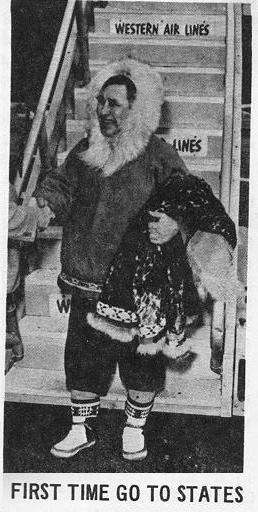
Now, while there do exist images of Chester Seveck where he isn't smiling, they are rare and mostly candid, taken while he's focused on doing something, like herding reindeer or singing, and often faced mostly away from the camera. They also tend to be from when he was younger, which the man in the image is clearly not. Given how frequently he was seen looking overjoyed just to be wherever he was, I find it a little bit unlikely that Chester would inspire an image I would go so far as to describe as 'frowning'.

image: Vic Warren
Now that's a bit more like Chester, but this isn't the original image. Rather, it's a later edit to make him smile, for Alaska's "fly with a happy face" campaign. I find it somewhat hard to believe that, were this Chester, it would have needed editing at all.
I also think that, were he to be the basis for the image, Chester would have brough it up when putting down his story. His memoir is from 1973, and the livery was introduced in 1972 with an even earlier newspaper ad featuring the same image. Chester had the healthiest high self-esteem I've seen in my life and he would definitely have mentioned this with pride. Maybe he was never told, but I suspect if this were the case he would have asked about it. It would be a little hard to not notice your own face on an airplane while greeting its occupants.
There's a major spanner in the works, though. That spanner is Vic Warren, designer of the initial Alaskana liveries, himself. Although it is no longer up, the Way Back Machine has helped me find an old post on his blog, discussing the logo and his design process. When I quoted him earlier, that's where I got it from. And he does kneecap my theory quite a bit - he outright states it's Chester.
Back in 1973, when I designed the Eskimo, an elderly Eskimo gentleman in Kotzebue was working as a greeter for the airline on its Arctic Tours. You got off the plane in Kotzebue and he was one of the folks who came up and helped you into a fur-trimmed parka to protect you from the cold. It was sort of an Eskimo version of the Hawaiian lei.
We had photos of him and others during the welcoming procedure. I used one of those photos as the basis for the art. His name was Chester Seveck Downey. Surprisingly, lots of rumors have announced that the art was based on all sorts of people, including Richard Nixon. Once, I heard a story that he was really Bob Marley!
So that should settle it, right? Maybe. Actually, though, I think Vic Warren may be misremembering. I don't mean to gaslight this artist who created an extremely recognizable and enduring logo, but he already states that the design was done in 1973, which is impossible because the liveries were introduced in 1972. He actually gives 1973 as a date throughout the post multiple times, even though I've seen it claimed the design was in the works as early as 1970. The post was first written in 2014, so I think it's perfectly reasonable for your memory to slip over 40 years.
Getting a date slightly wrong and forgetting who you based a logo on are two different levels, but I'd like to further argue my earlier point - if the reference truly was Chester greeting passengers I am absolutely sure he would have been smiling, and I can't imagine why Warren would have changed this in his art. I think it's possible he misremembered, and I also think it's possible he assumed the photograph of Oliver was of Chester somehow. Far be it from me to accuse someone I've never met of racism, but, look, most people fail implicit association tests. I think it is entirely plausible a (presumably) white man contracted by an airline he didn't work for personally could see a photograph of one indigenous man and just assume that it was of a different one he was more familiar with, especially if Oliver and Chester have similar faces, which I assume people who can tell think they do.
I don't think any of that conjecture is particularly convincing. I wouldn't personally be convinced by it. The burden of proof here is a lot higher than 'maybe he was confused'. But what finally swayed me to believing Amouack is most likely our man was a post on, of all sites, the digital sewer pipe known as Quora.
An aside: Quora has introduced a feature where at the top of the page you are given a response by ChatGPT. While this is going to give you an answer of higher quality than many of those provided by the 'human' users of the website, I find the answer it generated for this question both incredibly factually wrong and somewhat disrespectful.

So the most obvious thing is that ChatGPT is misgendering Oliver/Chester. This immediately makes it clear that this answer is fully nonsense to basically anyone sentient, though it still may well fool some Quora users. The 'names' given, Tlingit and Haida, are both those of indigenous Pacific Northwest peoples. As in ethnicities, not individuals. Fred Kabotie was a real person, and a real artist, and accomplished and prolific, and someone you should absolutely learn about, but he was not Tlingit - he was Hopi. As in, from Arizona.
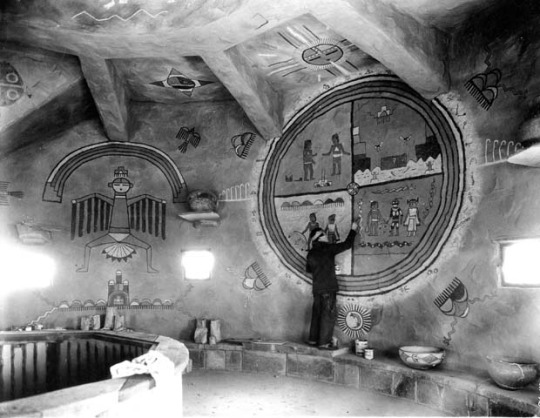
image: Grand Canyon National Park
I am rather confident Fred Kabotie has nothing to do with Alaska Airlines.
What really disturbs me is that, while there is an option to ask more questions in an app, and an option to downvote, there is no place to state that the information given is wrong, never mind to correct it. Even the app formerly known as Twitter has that.
Beyond that, there's no way to give this feedback to the bot. Downvoting isn't the same thing as actual negative reinforcement. This means that there is no way to stop the bot from giving the same answer to the same question in the future, even though it is wrong, and even though in this particular case a major aspect of its wrongness is that it seems to believe all North American indigenous people are one coherent group to the point it considers Hopi the same category as Iñupiaq, which is a bit like lumping together Spain and Norway.
So, not to pontificate, but this is one of the reasons ChatGPT is so potentially dangerous. It can generate text which seems quite a bit like an answer while being completely gibberish, and it could certainly fool people. Deep-learning algorithms, as of right now, are not capable of fact-checking. You should never rely on them for answers.
Besides that, though, there are actual human responses. Most of them are, as you may expect of Quora, total dreck. But sandwiched in between someone who seemed to be under the impression that it's ambiguous if Chester was from Kotzebue or Nome and someone who appeared to believe the term 'prop' didn't encompass turboprops was an answer given by Keith Holmes, whose qualifications are 'knows Dutch'.
That doesn't sound promising, but he actually came with evidence. I'm going to give you the short version, but you should read his answer. Here is his method:
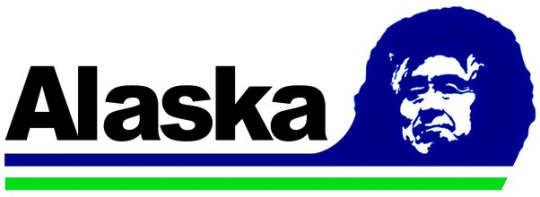
He took the original image of the logo, then flipped it horizontally to match the image of Oliver Amouack from the It's Alaska! poster.


Then he overlaid them and very slowly lowered the opacity. Like, it's torturously slow, so I'll just show some 'keyframes', but that slowness means that even I, faceblind as I am, could clearly see that they line up nearly perfectly.



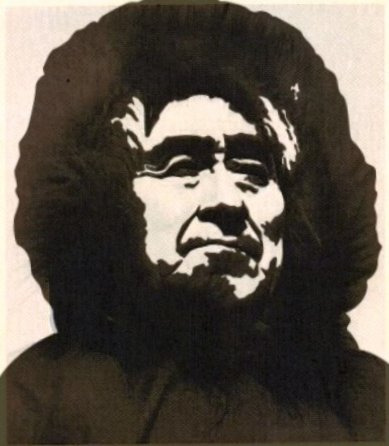

In the 1970s, this process would have been done with physical paint. But nowadays it's incredibly easy to just up the contrast and lower the saturation on an image. So Holmes (aptly named) did precisely this.
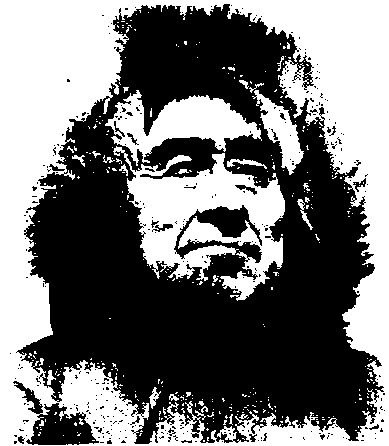
...yeah. I mean, there he is. I think we found him.
AN IDENTITY UNCOVERED
So, there it is. People's opinions vary about who this man is and whether he should be on the tails at all, but I think it's Oliver Amouack. But I want to finish off this post, which has had its ups and downs, on a somewhat open-ended yet positive note.
No matter who this face is, there are people who love him. And I'm not talking about people who love making money off him, or about senators. I mean regular Alaskans. Even Annie Wenstrup, in the original text of her petition, acknowledged that there is a warm fuzzy feeling that people have about him. Though its inclusion is definitely potentially a bit sinister, the Alaska Airlines page discussing the history of the logo released concurrently with the rebrand touches on it.
“When I see that face, I feel proud. I feel like I’m home,” says Sallee Baltierra, a concierge in Alaska’s Anchorage Board Room airport lounge. “I love to see that Eskimo on the tail in other cities that we fly to, from Liberia, Costa Rica to Nashville, Tennessee. It makes me feel like there’s a little piece of home there waiting for me.”
The ethics of how it is done in this particular case are worth discussing, and whether the logo as it stands now should be retired is not something I am in a position to weigh in on. For better or worse the happy face is part of Alaska Airlines' history. The mystery has been put out there for people to solve, and it won't go away if they take him off the planes.
And while there are good reasons, reasons I agree with, that people scoff at the idea of representation being the same thing as justice, particularly when those with no skin in the game are making millions off it, Alaskan Natives are most of the history of Alaska, and they have propped up Alaska Airlines from its earliest days. They have been pilots, cabin crew, ground crew, maintenance, customer service, passengers, and, yes, tour guides. They have been there from the earliest days of McGee Airways, and when Alaska Airlines finally goes under they will be there on its very last flight. There is a difference between acknowledgment and objectification, and that line is not one for me to draw, but it is at least good that the question of who this man is can lead people to the stories of the real people who are so often forgotten.
The fact that I believe the happy face is Oliver doesn't make that reality. It could well be Chester. It could be someone else. It could be your grandfather. It definitely isn't my grandfather, but I showed my mother a picture and she did say that he looks very much like my grandfather...we are not Alaskan Native, I think it goes without saying. I don't think anyone I'm related to has ever even been to Alaska.
But I think there's something positive to be taken from his anonymity to most of the world. There are certainly negatives, the sticking points of profit and objectification, but were it not for the fact that there was a mystery here to dive down I would have never known Chester Seveck existed, never mind read his memoir. I wouldn't have known Oliver Amouack existed either, and I hope I can read his memoir too. If there is any reason for me to 'well, actually' someone who says the face is definitely Chester - and I'm not sure there is - it wouldn't be because it isn't him, but because I want to give Oliver the same recognition.
And I hope other people wonder who the face is, and look for the answer online. My blog isn't very large, and I'm entirely happy with that. I love writing my incredibly niche posts about airlines, and I'm not doing this with any expectation or hope of fame. But given the small amount of articles on the topic I hope that my blog shows up in the search engine results, maybe on the second or third page, and that maybe it can direct someone to Chester's story. I am overjoyed to have read it and I want other people to read it too. His life was a unique and meaningful one and I am grateful that he chose to share it with the world. I am excited to pass it on to all of you.
I set out to find the identity of the man on Alaska Airlines' livery. What I found was the story of a man who touched far more than Alaska Airlines. The happy face could be anyone. He could be your grandfather. He could be (and probably is) Brenda Ritchey's grandfather. In a sense I think, although his literal family should be compensated for use of his likeness, he is your grandfather - not because he is literally your grandfather, but because he carries that poised warmth that so many grandfathers have. I think there is a real benefit to leaving this open-ended - at least enough to keep that mystique that drives people to make that Google search and learn about the overlooked and thought-to-be-nameless indigenous men who make Alaska what it is. Maybe the real happy face was the grandfathers we thought he resembled along the way.
And Alaska Airlines be damned, Chester Seveck herded reindeer for 46 years and had his dream of stars and sky beneath him come true. That's more valuable, to me, than having a famous picture based on you. Pictures reflect reality, but Chester was real, and it is accounts like his which make history human.
148 notes
·
View notes
Text
The Apache are a group of culturally related Native American tribes in the Southwestern United States, which include the Chiricahua, Jicarilla, Lipan, Mescalero, Mimbreño, Ndendahe (Bedonkohe or Mogollon and Nednhi or Carrizaleño and Janero), Salinero, Plains (Kataka or Semat or "Kiowa-Apache") and Western Apache (Aravaipa, Pinaleño, Coyotero, Tonto). Distant cousins of the Apache are the Navajo, with whom they share the Southern Athabaskan languages. There are Apache communities in Oklahoma and Texas, and reservations in Arizona and New Mexico. Apache people have moved throughout the United States and elsewhere, including urban centers. The Apache Nations are politically autonomous, speak several different languages, and have distinct cultures.
Historically, the Apache homelands have consisted of high mountains, sheltered and watered valleys, deep canyons, deserts, and the southern Great Plains, including areas in what is now Eastern Arizona, Northern Mexico (Sonora and Chihuahua) and New Mexico, West Texas, and Southern Colorado. These areas are collectively known as Apacheria.
The Apache tribes fought the invading Spanish and Mexican peoples for centuries. The first Apache raids on Sonora appear to have taken place during the late 17th century. In 19th-century confrontations during the American-Indian wars, the U.S. Army found the Apache to be fierce warriors and skillful strategists.

88 notes
·
View notes
Text
Gwich’in is a Dene (Athabaskan) language spoken in Alaska and northwest Canada.
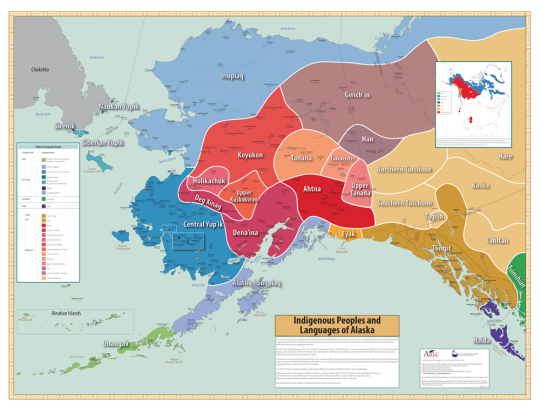
The language has an impressive set of sounds, with many different types of ejective consonants!
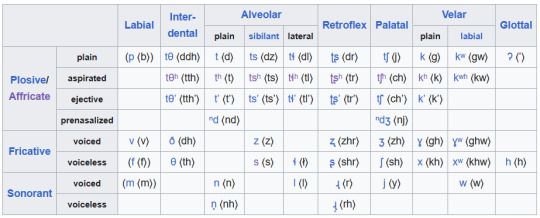
107 notes
·
View notes
Text
GREETINGS FROM MEOWTER SPACE.
In my travels I've come to find that I have an extremely strange family background. I'm going to be talking about it in some essays, which may contain descriptions of abuse and neglect. Here's the first one (it's long as fuck.)
On my mom's side, my great great grandmother was Creek. She was alive when I was born, and we briefly met. She was over 125 years old (nobody knows how old exactly.) The men on that side, who were all Scottish, died in their early 40s, except for my grandfather, who left when my mom was a kid. (I met him once, but my mom didn't want me to be around anyone Christian as a kid, so I never met anyone else on that side of the family.) I barely know anything about my Scottish ancestry, although growing up we called the native grapes "bullises," which is a Gaelic word for plums (they're also called muscadines, but I don't know what the truth is anymore.)
My family were subsistance farmers since before colonization, until my grandma became a schoolteacher. Our family moved to what would later be the Free State of Jones from what would later be Alabama, though I'm not sure why. During the Civil War, people in Jones county refused to fight, since nobody owned slaves in the area, and it was declared a Free State. My grandma lives in the Free State, in abject poverty with my uncle and his wife, who just scream at each other and beat their kids and neglect their 15 hoarded dogs all day. And if they have a problem with me saying so, they can eat shit and die.
My mom went to school for anthropology, and taught geology at the University of Southern Mississippi. She was extremely ashamed of how poor our background is, and I wasn't allowed to visit family much, although I wanted to very badly. I got to live with my grandma and my two adopted uncles who are around my age for a little while when we were kids, and they're some of the only positive childhood memories I have. I was extremely isolated and abused, especially by my step dad, who is currently (to my knowledge) employed as a programmer at a major video game company, as well as being a child molester starting when I was 2 or 3 years old (some of my earliest memories.) His name is Rigel Cameron Freeman. I ran away when I was 16 to live with my dad. When I told my mom what he did, she called me a liar and quit speaking to me, and that was the last I heard from her directly. So far as I know, she's been in mental hospitals pretty much since I left.
My dad's mom, whose first name was Ellen, was Ashkenazi Jewish, descended from a family who left Germany before the holocaust. She was a beatnik who was friends with Jack Kerouac and Allen Ginsburg, and she had personal beef with Grace Slick over a boyfriend. My dad's first guitar was a gift from Cat Stevens, although this was something he was a little embarrassed about and only mentioned to me once. She was especially close friends with Tiny Tim. She was in California trying to break into acting, and almost got a part in the Godfather allegedly (actually all of this is alleged by my dad, I only met her once. He really didn't like her, so I don't think he would make it up.)
Then she met my grandfather, Bob Marshall, who was probably in California to do drugs (sacred family tradition.) I have reason to believe he was mostly Choctaw and possibly Irish, although on that side of the family it's traditional to claim to be "French or Italian" unless you're very drunk, and then it's okay to be Indian. They moved up to Alaska and lived on the Athabaskan reservation, where my father, Rogan Russell Marshall, was born on April 19. Later, my grandfather became a civil rights lawyer, and he defended the right for prisoners with AIDS to be desegregated (basically anyone with AIDS would die in solitary before that.)
My dad got into Emerson, dropped out because no one could afford textbooks, moved to Mississippi and started this crazy punk band, and then went ahead and wrote some movies anyway. My favorite is called the Attic Expeditions, it features Seth Green, Jeffery Combs, and Alice Cooper, and it's very trippy and fun. Unfortunately, he became disabled from the same autoimmune condition I have, ankylosing spondylitis, which, if you're born male, has much more severe symptoms (which is why I chose not to start testosterone.) AS used to be thought of as genetic, but has recently been linked to environmental pollutants, and I was likely exposed to something released by one of our many chemical factories (my uncle who abuses his kids and dogs is adopted, I mentioned earlier, grew up in my grandma's house when we were kids together, and has the same symptoms, and multiple people who lived on the same Hattiesburg street as my dad in the 90s were diagnosed.) He was living in Massachussetts in his mom's basement when he married my step mom, a public defense attourney, to get health insurance, and they lived in Miami for eight years together until she left him, shortly after I moved in.
After that, I had to drop out of high school, and I lived in hell for about seven years while I worked full time, usually multiple jobs, to take care of us, and all the cats he would bring home (as many as 13, but I ran my house like a cat ranch and it was kind of beautiful.) His physical and mental health was dogshit, he wouldn't stop doing hard drugs, and our relationship was so hopelessly abusive that I had to quit speaking to him as well. My feelings are complicated because, while I love and admire his work, and he taught me a lot of extremely valuable and positive things, the things he did to me would put him in prison if I believed in the law. I owe him everything, and at the same time, I almost wish we'd never met (I'll have to talk about that in another post as well, because it's a lot, and exremely heavy.)
My third parent, Scott Panther, I honestly don't know very well. According to local legend, and there are many about him, he's Scottish and Cherokee. He was close friends with my parents before I was born, helped start Rong (and probably came up with the best ideas for it.) He was my mom's boyfriend for a long time before I was born.
My mom met Scott and Rogan at a Rong show, I was conceived after a Rong show (Scott drove Rogan to her house), and the night I was born there was a Rong show. Scott was overdosing when my mom went into labor, and I was born at 4 AM while multiple tornadoes passed through town. Later that night, he was ready to play the show (hats off). No one told Rogan I was born, though in the full video of the show he mentions the other people in town who were born on April 18. Unfortunately, the video is probably lost - he gave all the Rong tapes to someone I don't know, and he didn't say who (he may have even been lying and threw them away.)
I inherited a lot of personality traits from Scott, as many people who know us have noticed, although I gained them not through direct teaching, or through any modern understanding of genetics. I've read that before colonization these kind of things were more common and better understood.
27 notes
·
View notes
Text

Chief Walter Northway, 114, Athabaskan, Northway Alaska, RA Clayton #quietpride #indianchief
28 notes
·
View notes
Text
Someone about my Athabaskan Jet headcanon, probably: but you can't just make Avatar characters Alaska Native!!!!!!!!! They're only supposed to be Asian if they aren't Water Tribe, who are still cultural influenced by Mongolia and China!!!
Me: fuck you Sneers is part Haida now and Suki is part Yup'ik. Try it again and Chit Sang is next.
#haru is also part tlingit#i remember someone asking if there were any characters i don't headcanon as part native and like#maybe if we weren't expected to be happy with scraps just saying
110 notes
·
View notes
Photo

The state of Indigenous languages in Canada
by u/throwbarrieaway
There are 243,155 people in Canada that were recorded as being able to speak an Indigenous language in the 2021 census. This is 0.67% of the total population of Canada. However, this is still 100k more than the population with an Indigenous first language. Centuries of oppression have resulted in the decline of Indigenous languages in Canada, and revival efforts exist today among generations that did not grow up speaking the language.
The top 9 Indigenous languages in Canada are:
Cree (an Algonquin language) with 87,875 speakers. Called a language, group of languages or a language continuum, most Cree speakers in Canada simply say they speak Cree.
Inuktitut (an Inuktut language) with 41,680 speakers. The main language of the Inuit in Canada, and the only language other than English or French spoken by a majority in a province or territory.
Ojibway (an Algonquin language) with 26,165 speakers. Similar to Cree, Ojibwe (or Ojibway in the census) has many dialects, though most identify with the language as a whole.
Oji-Cree (an Algonquin language) with 15,305 speakers. Also called Severn Ojibwe, this is an "Ojibway-Potawotami language" language/dialect kept separate from the rest in the census.
Dene (an Athabaskan language) with 11,555 speakers. Also called Denesuline or Chipewyan, spoken mostly in the northern half of Saskatchewan, it is arguably the top language there depending on how you measure Cree.
Innu (an Algonquin language) with 10,745 speakers. The main language of the Innu of Northeastern Quebec and Labrador.
Mi'kmaq (an Algonquin language) with 9,245 speakers. Mi'kmaq is an Eastern Algonquin language of the Maritime Provinces.
Blackfoot (an Algonquin language) with 6,685 speakers.
Atikamekw (an Algonquin language) with 6,815 speakers. In the Cree-Innu group, spoken mostly in the Saint-Maurice watershed north of Montreal.
Full stats can be explored in this table:
https://www12.statcan.gc.ca/census-recensement/2021/dp-pd/prof/details/page.cfm?LANG=E&GENDERlist=1&STATISTIClist=1&DGUIDlist=2021A000011124&HEADERlist=18
Note on "Insufficient Speakers". Stats Canada has an anonymity filter on all data that turns any response below 10 people to 0. So, in the top right map that means less than 10 speakers of an indigenous language. In the main map that means less than 10 speakers of an individual language family, and the unstriped Algonquin divisions have less than 10 speakers of one of the four individual subgroups.
Source: Census 2021, Knowledge of Languages by Census Division. Tools: QGIS, Excel
195 notes
·
View notes
Text
Fallout, BUT ALASKA????
My ass is going feral over Fallout in Alaska since I live there, so here's my rant about what I think it would be like/lore building for my characters!
Location:
Alaska, duh, but AK is a HUGE state, so I chose Anchorage (how could I not), the Matsu Valley, and a little into Hatchers Pass and Chugiak Nat. Park! Here a map

I chose this area cause it is literally the best part to make a game/story! It's smashed between mountains, large cities, and many fun sites! (Elmendorf AFB, Hatcher Pass Mine/Ski area, so much farmland in Palmer, and infrastructure in Wasilla!!!)
Factions:

Enclave: Remnants of the Sino-American war scattered across the land had contact with the oil rig in FO3 and patiently waited for the word (Will never get the word, abandoned). Currently consolidating in Fort Richersond and Elmendorf AFB.
Chinese Remnants: Pushed Westward by Enclave, weak and keeping their distance from other factions. Will let some Dena'ina people in to trade.
USSR Remnants: Holding out in Chikaloon (gonna be honest, I have no idea what I wanna do with these guys,,, brainstorming)
Dena'ina Federation: Like the Boomers and Great Khans in FVN, these are a 'lesser' faction but still very powerful. They have significant snow machines (the main form of transportation for most of the months) and supplies and are willing to trade. The tradition of Potlatches continues, but most need help understanding their kindness.
(Let me know if ya'll have any ideas for what I should do with these guys!!!)
Critters:
EHEHEHEHEHEHEH, MY FAVORITE PART!!!
Radmoose: Unlike the Radstag in 4, Radmoose are like death claws here! They have gone from 6 foot 800 pounds to 8 foot 1200 pounds! Moss-ridden pelts and alters spanning 7 feet and glowing with rads, these are animals you do not wanna mess with. They attack on sight and stomp you until you are nothing but mush on the frozen ground.
Shirs: Mutated Black bear! The name comes from the Athabaskans, almost the same as Yaio gyu but with more fur and appears quieter. They often sneak up on unsuspecting travelers. Some are trying to study their silent way of moving.
Rad Salmon: Fishing is a huge part of life here, so I had to add aquatic life! Bigger, redder, and meaner, these fish are a favorite among all the factions. They have more prominent teeth, thicker skin, and a couple more eyes than usual. Legend says if you find the King Salmon, you'll be granted special powers ;)
Kosatka: Killer whales have been spotted closer to land than usual. They are about the same but have a greener tint to them! Do not go on the ice at all cost, cause Kosatka are known to use this tactic to hunt anything that comes onto the ice.
(I'll be adding more as I come up with them!)
4 notes
·
View notes
Photo


Apache girl and papoose. 1903
Apache-Geronimo
Apache
The Apache are a group of culturally related Native American tribes in the Southwestern United States, which include the Chiricahua, Jicarilla, Lipan, Mescalero, Mimbreño, Ndendahe (Bedonkohe or Mogollon and Nednhi or Carrizaleño and Janero), Salinero, Plains (Kataka or Semat or "Kiowa-Apache") and Western Apache (Aravaipa, Pinaleño, Coyotero, Tonto). Distant cousins of the Apache are the Navajo, with whom they share the Southern Athabaskan languages. There are Apache communities in Oklahoma and Texas, and reservations in Arizona and New Mexico. Apache people have moved throughout the United States and elsewhere, including urban centers. The Apache Nations are politically autonomous, speak several different languages, and have distinct cultures.
https://en.wikipedia.org/wiki/Apache
63 notes
·
View notes